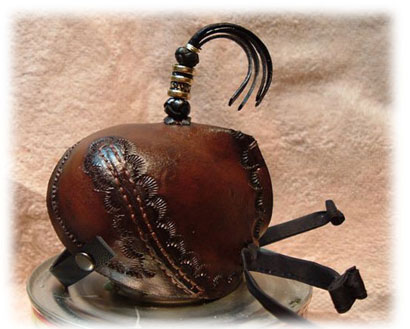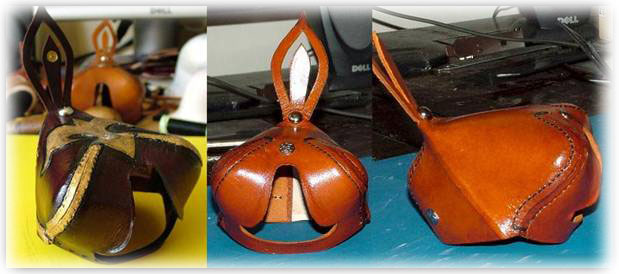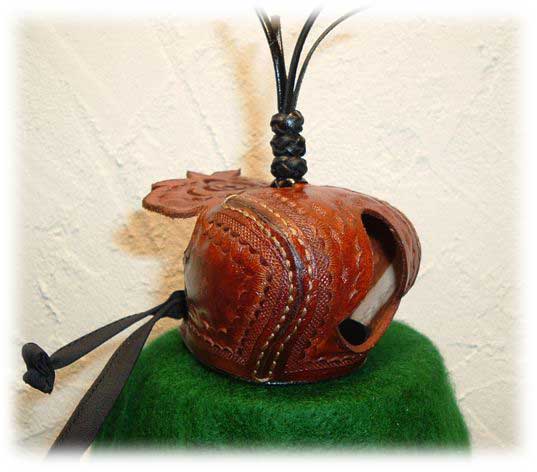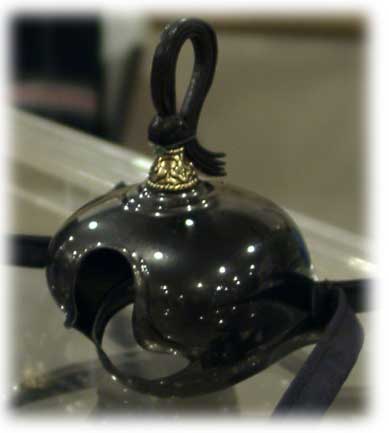
 oods are an Arab contribution to falconry brought to Europe by the Crusaders. Each regional group, and each individual hood maker, puts his own stamp on the hoods with original innovations and changes. Hoods are called "burqa" in Arabic falconry. "Rufter" is the traditional European falconry term for a trapping hood.
oods are an Arab contribution to falconry brought to Europe by the Crusaders. Each regional group, and each individual hood maker, puts his own stamp on the hoods with original innovations and changes. Hoods are called "burqa" in Arabic falconry. "Rufter" is the traditional European falconry term for a trapping hood.
The purpose of a hood is to calm the bird. These birds are so visually oriented that they are not fearful of what they cannot see. If they cannot see it, then it must not be there. A freshly trapped bird with a hood on will eat on the fist within minutes or hours of trapping, even if it is standing on the fist of a person. Simply because she cannot see anything alarming, there is nothing to be alarmed about. Hoods protect the bird and allow ease of control of situations that otherwise could be startling to the bird.
A bird should hood calmly (note the large crop on this bird) Bird being hooded - 803 Kb
Hoods are made of leather, either calf skin or more preferably kangaroo hide. Thinner and more stiff (for certain styles) is preferred. Braces are traditionally made of leather, but more recently made of GoreTex strips. Decorations can be done using dyes, various skins such as lizard, or feathers. Stitching should be done with waxed thread to ensure strength and longevity. Hoods should always be stored open, not closed.
Leather hoods made with the smooth side out around the face are lacquered for the longest life-span. This allows the smooth leather to be cleaned well if the bird eats in the hood. The rest of the hood around the back and over the eyes may be suede which won't show as much wear if the bird scratches. For trapping hoods it doesn't matter as they are intended for short term usage. Braces should be stiff so that they do not touch any of her feathers and short enough that the bird cannot bite them. The base of the beak opening must be wide enough to allow for the bird's beak to open. If this opening is not large enough, the hood will not fit properly and the bird will resent it.
 |
A hood that did not fit perfectly has slightly bruised this bird. Simply replacing the hood with a better fitting one will let this heal in a couple of days. This is very minor. |
Hood fit comes from two main attributes - eye clearance and gape fit. The contouring for the eyes must give enough clearance that the eye is not interfered with. Hoods are sized by measuring across the top of the hood looking down on it for the widest points. A large female Red-Tail or Gyrfalcon will measure about 2.5" or a slightly smaller 2.4" across. A Peregrine, female Harris' Hawk, male Red-Tail, or female Goshawk will measure roughly 2.3" across. Hoods are typically offered in 1/8" graduations. The hood itself should be watched to make sure there is no sign of weeping coming from the eyes. This means that the hood is rubbing or irritating the eye in some way.
If the gape does not fit properly, it can hit the cere or gape and bruise it or generally cause discomfort. The beak opening may or may not allow your bird to cast. If she is unable to cast through the hood, it must be removed to allow her to cast properly. A definite advantage is a hood that has an adjustable chin strap (especially a dropped or angled chinstrap) so that you can adjust it to more accurately fit your bird. Much of the beak fit can be adjusted by the falconer and not the hoodmaker making the hood under construction more tolerant of a variety of bird gapes. For this reason it is critical that the eye clearance is appropriate - the beak clearance can be adjusted later.
 |
The widest point here is where the eye area is. You would measure this distance across the top of the hood.
Hood by Larry Ray |
 |
This bird had a hood that appeared to fit perfectly, but in fact was rubbing the chinstrap against her mandible wearing a spot raw and creating an open wound. She healed quickly once it was noticed and corrected. |
The third point of fit is the closure on the back of the hood can make a great difference to your bird. If the feathers tend to get caught, this will make her very uncomfortable. If the back of the hood doesn't have enough room, the hood will apply pressure to the bird's head and cause discomfort. Putting a hood on the bird and leaving it for an hour or two will tell a lot about the fit. When the hood is removed the feathers will ideally be unruffled. Most hoods will ruffle the feathers slightly, but the best fitting, perfect hood will come off the bird and not leave the bird with the feathers crushed or molded in any way.
The top knot is traditionally a Turk's head knot, but can be a bead, horsehair, feather plume, or anything else. The purpose is beyond decoration - it is to be able to push back on the hood to seat it well on the hawk's head, and to push forward to strike the hood (open the braces and remove the hood).
The braces are in pairs with one on each side having a knot at the end and one on each side not having a knot. The braces are drawn (closing the hood) by pulling the unknotted pair together, and the hood is opened by pulling the knotted pair. Usually this is done by using your right hand to work the brace on the bird's left side while grabbing the matching brace with your teeth.
Hoods may be formed through gluing or stitching, and sometimes both. A stitched hood takes longer to make, but is considered a real showpiece when executed by a master. However stitching may stretch over time, especially if the bird scratches at it. Gluing is faster and generally holds a more light-tight seam, but some falconers look down on it as a less then ideal hood. Glued hoods tend to be stronger than stitched hoods and are less expensive.
The hood weight should not be too heavy. This is a bird of relatively light muscle weight and not able to have much weight on the head. The least amount of weight that the hood can be is preferred.
Hood Styles
Arab or BahrainiThe Arab hood is marked by the circular pattern to make the hood fit the contours of the eyes and head. These are typically molded on a block and have a flat back with the braces woven in and out of leather pleats making an accordion of the back's base. The advantage of this style of brace closure is that it is smooth and tends not to catch the bird's crest feathers. With the long crest feathers that eagles have, this is a good choice for hood closure for eagles. Birds who are sensitive to their crest feathers getting caught in the brace closure, like Goshawks, might also consider this style closure to avoid annoying the bird. However, the disadvantage to this is that it is more easily tossed off by the bird before it has been closed making a hard to hood bird even more difficult. Hoods where the braces catch the feathers can have a very thin piece of leather glued to the inside to smooth the feathers against her head preventing them from catching in the hood.
 |
Arab style hood Note that the top knot here has been replaced with a metal bead. |
 |
Arab style braces Note that when pulled closed the back would be pleated like an accordion. |
Dutch
Traditionally made from a three pieces, this has more recently been made from a single piece of leather as well. The Dutch hood has an inverted V opening in the back where the braces close. The advantage to this is that it causes the hood to catch on the crest feathers making even an open hood less likely to be shook off the head. The disadvantage to this opening is that it can catch the crest feathers in the braces and irritate the bird. This V may be filled in with a flap of leather that the braces pass through such that when closed the leather in this V looks like an accordion. This leather flap is to keep the feathers from getting caught in the braces. The hood features a contoured beak opening allowing the contouring to be rolled back to better fit the bird's beak opening and cere. Traditionally this is molded on a block form called a Mollen block. It is thought that the Damascus style hood is the most direct predecessor to the Dutch style hood.
Generally considered to be the best fitting for the widest range of birds. Although traditionally the Dutch hood style was used exclusively on falcons, a good, well-made Dutch hood will properly fit a hawk, falcon, or accipiter of the right size.
 |
Dutch style braces Note that the hood itself is not a traditional Dutch hood, this just illustrates the braces. |
Dutch Hood pattern software - shareware
Indian, Pakistan, or Amritsari
This hood style is from Pakistan and is sometimes also known as the Indian hood (outside the Indian subcontinent). This hood style is marked by a straight line where the leather meets that makes the contours of the hood. The triangular beak opening is sometimes replaced with a Dutch style "bell shaped" opening to better fit the bird. Traditionally this hood is not blocked.
Generally thought to best fit Accipiters, eagles, and Ferruginous hawks, many falconers dislike this hood style and prefer the Dutch hood for all their various species.
 |
Pakistan style hood.
Photos courtesy of Salman Ali. |
British "Game Hawkers" Hood
This hood style is from Britain and is known as the Game Hawkers hood. This is Griff Morgan-Jones' version of the traditional British "Game Hawking" hood (red felt eye panels). The plume would be made from the first type of game caught with the falcon, Pheasant in this case. So when falcons were carried on the cadge you could quickly see the required falcon by the color of the eye panels and the type of feathers in its plume.
Green felt eye panels would be used for a Crow hawk.
 |
British Game Hawkers hood by Griff Morgan-Jones.
Photo courtesy of Griff Morgan-Jones. |
Kazakh
The tab at the top or back of this hood serves the same function as the more familiar top knot. This hood originated in Mongolia and is used by the Kazakh falconers most typically on Golden Eagles.
Khan
This hood was designed by Ken Hooke and is a modern modification of hood styles from three other countries: Syria, Dubai, and Turkey.
 |
Khan hood made by Ken Hooke
Photo courtesy of Ken Hooke. |
 |
Three different styles of Khan hoods, from left to right - The Khan, the Spanish Khan, and the Bonelli Khan
Photo courtesy of Ken Hooke. |
 |
Mjooke Khan hood designed and made by Griff Morgan-Jones.
Photo courtesy of Griff Morgan-Jones. |
Ferrug Buteo Hood
This hood was designed by Ken Hooke and is a modern modification using an adjustable chin strap which allows you to adjust the proper beak opening assuring a comfortable fit for your buteo.
 |
Ferrug hood made by Ken Hooke
Photo courtesy of Ken Hooke. |
 |
Ferrug hood made by Ken Hooke
Photo courtesy of Ken Hooke. |
Sugisaki Dutch Chinstrap Hood
This hood was designed by Kazuhiko Sugisaki and is a modern modification of a Dutch hood pattern using an adjustable chin strap.
 |
Dutch hood with an adjustable chinstrap made by Kazuhiko Sugisaki
Photo courtesy of Kazuhiko Sugisaki. |
 |
Dutch hood with an adjustable chinstrap made by Kazuhiko Sugisaki
Photo courtesy of Kazuhiko Sugisaki. |
Sugisaki Pakistan
This hood is a modern modification of a Persian style hood developed by master hood maker Kazuhiko Sugisaki of Japan. It is sometimes called the Artistic Hood.
 |
Pakistan hood by Kazuhiko Sugisaki
Photo courtesy of Kazuhiko Sugisaki. |
 |
Pakistan hoods by Enrique Ruiz
Photo courtesy of Enrique Ruiz. |
Sugisaki Hood
This hood is a new modification combining a Dutch pattern with a Pakistan pattern developed by master hood maker Kazuhiko Sugisaki of Japan.
 |
Sugisaki hood by Kazuhiko Sugisaki
Photo courtesy of Kazuhiko Sugisaki. |
Austringer Field Hood
This hood is a modern blocked modification of the traditional Kazakh slip-on hood. Designed by Ken Hooke, these field hoods simply slip-on when your bird needs to be hooded. Because there are no braces, removal is quick and easy for slips or controlling birds in the field. These hoods are for field work only, they should not be used in the mews or when your hawk needs to be hooded for long periods. These are particularly well suited for Accipiters and hawks.
 |
Austringer Field Hood designed and made by Ken Hooke
Photo courtesy of Ken Hooke. |
Berkutchi Hunter Hood
This hood is a modern modification of the traditional Kazakh slip-on hood; designed by Griff Morgan-Jones, these field hoods simply slip-on when your Eagle needs to be hooded. Because there are no braces, removal is quick and easy for slips or controlling Eagles in the field. These hoods are for field work only; they should not be used in the mews. These hoods are very versatile as one eagle hood size can fit eagles that weigh in from 8 to 12 pounds; they are made for the Golden Eagle but will also fit Bald Eagles as well. The hood pattern can also be reduced in size to fit the female Ferruginous, Red-Tail, and Harris Hawk.
 |
Berkutchi Hunter Hood designed and made by Griff Morgan-Jones
Photo courtesy of Griff Morgan-Jones. |
 |
Berkutchi Hunter Hood designed and made by Griff Morgan-Jones displayed on a Golden Eagle
Photo courtesy of Griff Morgan-Jones. |
Hu Hood
Designed by Ken Hooke, these field hoods are designed for hot desert hunting. The Hu Hood came about by a request from a falconer in the deserts of Dubai. He needed a light weight hood that wouldn't over-heat the bird's head; this design allows for air flow and heat exchange.
 |
Hu Hood designed and made by Ken Hooke
Photo courtesy of Ken Hooke. |
 |
Hu Hood designed and made by Ken Hooke
Photo courtesy of Ken Hooke. |
This is a hood created by High-Tech Falconry made of a poly-carbonate material. This material allows the hood to be very light weight and yet durable. It is usually 30% lighter than a conventional leather Dutch hood. The hood design features a traditional beak opening, a Dutch style closure with GoreTex braces, and a traditional topknot fixture. High-Tech Falconry also makes a vented hood that allows air to the eye, while keeping the light out. This hood was designed for birds that condensate excessively in the hood or birds that are kept in the hood for long periods of time. The disadvantage of these hoods is that the individual falconer cannot make the tiny adjustments they are used to making on a traditional leather hood. Adjustments have to be made by the manufacturer.
 |
The High Tech Molded Plastic Hood designed and made by Justin Tanner and Mike Todd. |
Kinran
This hood is made with Japanese Kinran cloth.
 |
Kinran hood by Kazuhiko Sugisaki
Photo courtesy of Kazuhiko Sugisaki. |
Anglo-Syrian or Syrio-Dutch
This is a Dutch hood modified to have the Arab accordion back opening here designed by Griff Morgan-Jones.
 |
The MJ Dutch-Arab Hood designed and made by Griff Morgan-Jones.
Photo courtesy of Griff Morgan-Jones. |
Sultan Hood
This is a hood based on the traditional Slijper design. The hood completely wraps around to the back, and is not blocked. This hood is intentionally made soft so that it will form to the bird's own head and stretch in the chinstrap over time. Designed by Griff Morgan-Jones.
 |
The Sultan Hood designed and made by Griff Morgan-Jones.
Photo courtesy of Griff Morgan-Jones. |
Anglo-Indian
This has aspects of both the Indian type and another type, most typically this is an Indian pattern with Dutch braces. A much more recently developed hood, probably somewhere in the 19th century. This hood is usually not blocked or molded.
Afghanistan
Similar pattern to the Indian hood, except the chin strap is a separate piece attached to the hood.
Other Modifications
Spring-wire BraceSome hoods have been made with a spring on the back such that once the hood is seated the back snaps closed. This spring-wire brace is particularly useful for a bird who will not hood easily.
There is a full article by Gaylen Gerrish in the December 1998 issue of NAFA's Hawk Chalk.
  |
Spring-wire brace design by Gaylen Gerrish
Photo courtesy of Gaylen Gerrish. |
Some have poked small holes in the hood near the eye section allowing the bird some light and some view out as a way to introduce her to the world outside the hood slowly and in a controlled manner.
Others have put vent holes on top to allow for breathability.
For sick raptors where a hood needs to be cleaned before being used again, or trapping raptors where the bird's hood size is not known ahead of time, there are some good temporary options. Cat muzzles that have a velcro closure can be bought relatively cheaply and in different sizes allowing you to toss them in the washing machine, sterilize, disinfect, or discard the "hood" and yet control the bird while keeping her comfortable. Golf club socks can also work well, particularly the ones with velcro around the opening. They cannot see through these, yet can breathe easily.
Resources
Roger Upton's book Falconry - Principles & PracticeMaking a hood